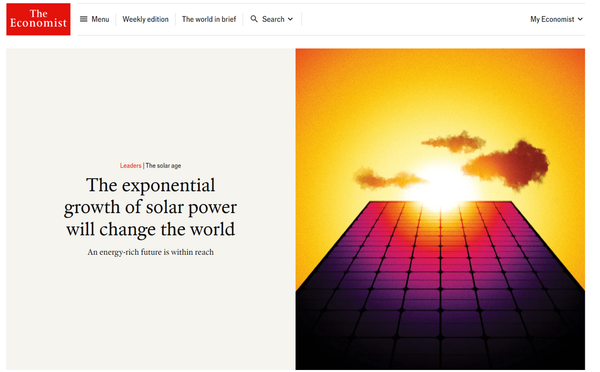0

READING: The exponential growth of solar power will change the world
a year agoI am a subscriber to the Economist and I want to share a fantastic article I read today. It's a long text more suitable to advanced level, or upper intermediate level people at the minimum. It's a very interesting article. Please read and enjoy!
Read the following text from the Economist and answer the questions. We'll check your answers and discuss the speaking part in the lesson, if you decide you want to do the activity.
Comprehension
- What anniversary is being marked for the unveiling of the technology to turn sunlight into power by AT&T's Bell Labs?
- What percentage of the world’s electricity will solar panels provide this year?
- By what decade are solar cells expected to become the single biggest source of electrical power on the planet?
- According to the text, why does solar power face no constraints similar to earlier energy transitions?
- What are the three abundant resources needed to produce solar cells mentioned in the text?
- Why is it concerning that most of the world's solar panels come from China?
- What impact does the text suggest cheaper energy from solar power will have on society and technology?
Speaking
- Exponential Growth of Solar Power: The text mentions that installed solar capacity doubles roughly every three years. What challenges and opportunities do you think this exponential growth presents for the global energy market and infrastructure?
- Dependence on Chinese Solar Industry: Given that the vast majority of the world’s solar panels come from China, what are the potential risks and benefits of this dependence? How can other countries mitigate these risks while still expanding their solar capacity?
- Solar Energy and Climate Change: The text states that while solar power will not stop climate change, it could slow it down significantly. What complementary technologies or policies do you think are necessary to maximize the impact of solar energy on mitigating climate change?
- Economic and Social Impacts: Cheaper solar energy is said to have the potential to transform economies and improve living standards. What are some specific examples of how affordable solar power could change daily life in both developed and developing countries?
- Future Innovations: The text suggests that the most consequential impacts of cheaper solar energy will be things nobody has yet thought of. What are some potential innovations or industries that could emerge from the widespread availability of inexpensive solar power? How might these innovations shape the future?

It is 70 years since at&t’s Bell Labs unveiled a new technology for turning sunlight into power. The phone company hoped it could replace the batteries that run equipment in out-of-the-way places. It also realised that powering devices with light alone showed how science could make the future seem wonderful; hence a press event at which sunshine kept a toy Ferris wheel spinning round and round.
Today solar power is long past the toy phase. Panels now occupy an area around half that of Wales, and this year they will provide the world with about 6% of its electricity—which is almost three times as much electrical energy as America consumed back in 1954. Yet this historic growth is only the second-most-remarkable thing about the rise of solar power. The most remarkable is that it is nowhere near over.
Solar power is going to be huge
China’s giant solar industry is in turmoil
Private firms are driving a revolution in solar power in Africa
To call solar power’s rise exponential is not hyperbole, but a statement of fact. Installed solar capacity doubles roughly every three years, and so grows ten-fold each decade. Such sustained growth is seldom seen in anything that matters. That makes it hard for people to get their heads round what is going on. When it was a tenth of its current size ten years ago, solar power was still seen as marginal even by experts who knew how fast it had grown. The next ten-fold increase will be equivalent to multiplying the world’s entire fleet of nuclear reactors by eight in less than the time it typically takes to build just a single one of them.
Solar cells will in all likelihood be the single biggest source of electrical power on the planet by the mid 2030s. By the 2040s they may be the largest source not just of electricity but of all energy. On current trends, the all-in cost of the electricity they produce promises to be less than half as expensive as the cheapest available today. This will not stop climate change, but could slow it a lot faster. Much of the world—including Africa, where 600m people still cannot light their homes—will begin to feel energy-rich. That feeling will be a new and transformational one for humankind.
To grasp that this is not some environmentalist fever dream, consider solar economics. As the cumulative production of a manufactured good increases, costs go down. As costs go down, demand goes up. As demand goes up, production increases—and costs go down further. This cannot go on for ever; production, demand or both always become constrained. In earlier energy transitions—from wood to coal, coal to oil or oil to gas—the efficiency of extraction grew, but it was eventually offset by the cost of finding ever more fuel.
As our essay this week explains, solar power faces no such constraint. The resources needed to produce solar cells and plant them on solar farms are silicon-rich sand, sunny places and human ingenuity, all three of which are abundant. Making cells also takes energy, but solar power is fast making that abundant, too. As for demand, it is both huge and elastic—if you make electricity cheaper, people will find uses for it. The result is that, in contrast to earlier energy sources, solar power has routinely become cheaper and will continue to do so.
Other constraints do exist. Given people’s proclivity for living outside daylight hours, solar power needs to be complemented with storage and supplemented by other technologies. Heavy industry and aviation and freight have been hard to electrify. Fortunately, these problems may be solved as batteries and fuels created by electrolysis gradually become cheaper.
Another worry is that the vast majority of the world’s solar panels, and almost all the purified silicon from which they are made, come from China. Its solar industry is highly competitive, heavily subsidised and is outstripping current demand—quite an achievement given all the solar capacity China is installing within its own borders. This means that Chinese capacity is big enough to keep the expansion going for years to come, even if some of the companies involved go to the wall and some investment dries up.
In the long run, a world in which more energy is generated without the oil and gas that come from unstable or unfriendly parts of the world will be more dependable. Still, although the Chinese Communist Party cannot rig the price of sunlight as opec tries to rig that of oil, the fact that a vital industry resides in a single hostile country is worrying.
It is a concern that America feels keenly, which is why it has put tariffs on Chinese solar equipment. However, because almost all the demand for solar panels still lies in the future, the rest of the world will have plenty of scope to get into the market. America’s adoption of solar energy could be frustrated by a pro-fossil-fuel Trump presidency, but only temporarily and painfully. It could equally be enhanced if America released pent up demand, by making it easier to install panels on homes and to join the grid—the country has a terawatt of new solar capacity waiting to be connected. Carbon prices would help, just as they did in the switch from coal to gas in the European Union.
The aim should be for the virtuous circle of solar-power production to turn as fast as possible. That is because it offers the prize of cheaper energy. The benefits start with a boost to productivity. Anything that people use energy for today will cost less—and that includes pretty much everything. Then come the things cheap energy will make possible. People who could never afford to will start lighting their houses or driving a car. Cheap energy can purify water, and even desalinate it. It can drive the hungry machinery of artificial intelligence. It can make billions of homes and offices more bearable in summers that will, for decades to come, be getting hotter.
But it is the things that nobody has yet thought of that will be most consequential. In its radical abundance, cheaper energy will free the imagination, setting tiny Ferris wheels of the mind spinning with excitement and new possibilities.
This week marks the summer solstice in the northern hemisphere. The Sun rising to its highest point in the sky will in decades to come shine down on a world where nobody need go without the blessings of electricity and where the access to energy invigorates all those it touches.
VOCABULARY
- Exponential: Meaning: Growing very quickly and becoming much larger in a short time.
- Seldom: Meaning: Not often; rarely.
- Ten-fold: Meaning: Ten times as much or as many.
- Hedonic treadmill: Meaning: The idea that people stay at the same level of happiness even if they get more money or success.
- Virtuous circle: Meaning: A positive cycle where one good thing leads to another, making the situation better and better.
- Constraint: Meaning: A limit or restriction.
- Proclivity: Meaning: A natural tendency to do something regularly.
- Outstrip: Meaning: To be or become greater than something else.
- Pent up: Meaning: Held back or restrained for a long time.
- Tariffs: Meaning: Taxes or duties placed on imported goods to protect domestic industries.
